Butterflies are one of the most popular insects. We introduce you to the fifteen most beautiful butterfly species native to Germany.

When you think of summer meadows and gardens, you also think of the colorful butterflies. Their diversity is also colorful with around 3700 species in Germany. Unfortunately, many are now threatened. In the last ten years the number of native butterflies has decreased by ten percent and more and more species are classified as endangered. What can be done about it? Colorful gardens where things can get a little wilder. Below, you'll learn about ten wonderful species of native butterflies that will thank you for it.
contents
- 1. Pigeon tail (Macroglossum stellatarum)
- 2. Painted Lady (Vanessa cardui)
- 3. Brimstone butterfly (Gonepteryx rhamni)
- 4. Peacock butterfly (Inachis io)
- 5. Swallowtail (Papilio machaon)
- 6. Little fox (Aglais urticae)
- 7. Admiral (Vanessa atalanta)
- 8. C-butterfly (Polygonia c-album)
- 9. Chess board (Melanargia galathea)
- 10. Aurora butterfly (Anthocharis cardamines)
- 11. Big fox (Aglais polychloros)
- 12. Imperial coat (Argynnis paphia)
- 13. Mourning cloak (Aglais antiopa)
- 14. European blue-hackle (Polyommatus icarus)
- 15. Little meadow bird (Coenonympha pamphilus)
Depending on the environmental conditions, butterflies develop special shapes and colors. Extensive research was carried out around 1900: It was found that high or low temperatures and unusual food during the caterpillar stage lead to extreme deviations. This explains why individual species look different than they should in certain areas or particularly hot years. Particularly large effects were observed with the mourning cloak, which showed clear characteristics of the great fox when exposed to the cold. In the following, we introduce you to 10 native butterfly species that you might also come across in your garden.
1. Pigeon tail (Macroglossum stellatarum)
The pigeon tail is a very unusual butterfly. It is particularly noticeable because of its weighty body. At first glance, it is sometimes confused with a hummingbird, even if hummingbirds are of course not found in Europe. However, this comparison is not so absurd, because its size and especially the property of hovering in front of a flower result in similarities. Pigeon tails have a trunk about three centimeters long that allows them to drink in flight. Above all, they choose flowers with a long calyx. The fast, agile animals usually migrate to Mediterranean regions in winter, but recently more and more pigeon tails have been overwintering in Germany.

2. Painted Lady (Vanessa Cardui)
Unfortunately, if you want to discover the painted lady in winter, you will look in vain. In fact, the pretty butterfly only occurs in Germany from April to September and moves to warmer climes in winter. The small animals fly up to 4,000 kilometers into the Ethiopian highlands - one of the longest known insect migrations in the world. With its striking orange color, which is highlighted by black and white patterns, the painted lady impresses above all with its appearance. In addition, the adult animals are extremely lovable beneficial insects, which above all reliably pollinate thistle flowers. The caterpillars of the painted lady like to use scratching thistles (Cirsium), the great nettle (Urtica dioica) or mallow family (Malvaceae) as fodder plants.
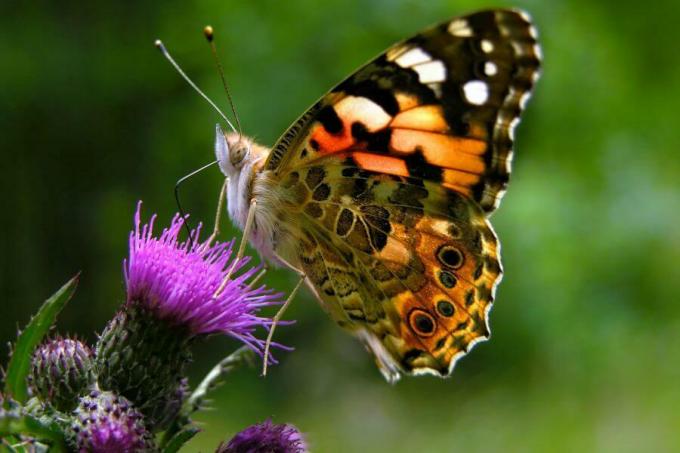
3. Brimstone butterfly (Gonepteryx rhamni)
The first butterfly to flutter around in spring is the brimstone butterfly. He has the amazing ability to excrete a large part of his body fluids in the cold winter and to be able to withstand temperatures as low as -20 ° C. As soon as it gets a little warmer again, it wakes up from its winter dormancy. In midsummer the animals then fall into a second resting phase, the summer dormancy. They are the only German butterflies that can live up to ten months. Lemon butterflies are easy to recognize due to their characteristic, leaf-like wings. Male specimens are lemon yellow, while female animals are more greenish-yellow in color.

4. Peacock butterfly (Inachis io)
The peacock butterfly is one of the most common butterflies in Germany, Austria and Switzerland. It is easy to recognize by its four large peacock eyes on the red-brown upper side of the wing. Because the animals do not migrate, but in slightly damp places such as in cellars or burrows in the ground hibernate, they are one of the butterflies that are the first to come back in spring as soon as it comes gets warmer. The caterpillars of the peacock eye are also easy to spot. They sit almost exclusively on nettles and are deep black with white dots. The butterfly's defense strategy is striking: if an attacker approaches, the peacock butterfly hits quickly with the wings to bring out the eyes and gives a loud hiss of themselves.

5. Dovetail (Papilio machaon)
With a wingspan of up to eight centimeters, the magnificent swallowtail is one of the largest of our native butterflies. Its wings are conspicuously patterned with a blue stripe on the lower edge and the elongated appendages. The populations of the impressive butterfly have recovered in recent years, and so it can be seen again and again in flower meadows or in gardens. He is particularly fond of gardens with carrots, dill and fennel. During the mating season between May and August, the swallowtails can also often be seen on hilltops, where males and females meet. The female lays the eggs on individual umbelliferae, but always so few that the caterpillars do not damage the plant too much.
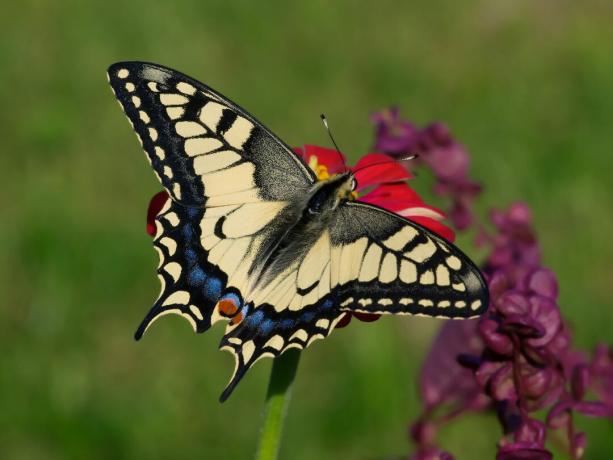
tip: Would you like to attract more native butterfly species to your garden or balcony? Then you are with ours Plantura butterfly meeting precisely. Simply sow the mixture of annual and perennial butterfly-friendly plants in a bed or in a pot and you will soon be able to observe the colorful fluttering.
6. Little fox (Aglais urticae)
Orange-brown wings with bright blue dots on the edge: The little fox is extremely popular because of its pretty shape. In Germany, the little fox is common in summer and is one of the most popular butterfly species. In fact, the noble butterfly is a hardworking pollinator and shines with more than just its looks. The Kleiner Fuchs flies to well over 200 different nectar plants. In addition to numerous native plants such as the water deast (Eupatorium spec.) include exotic garden plants such as the butterfly lilac (Buddleja). If you want to offer the beautiful butterflies a home, you should not only pay attention to abundant flowering plants: the caterpillars of the small fox feed almost exclusively on the great nettle (Urtica dioica), which is why the moths are often found in the vicinity of these plants.
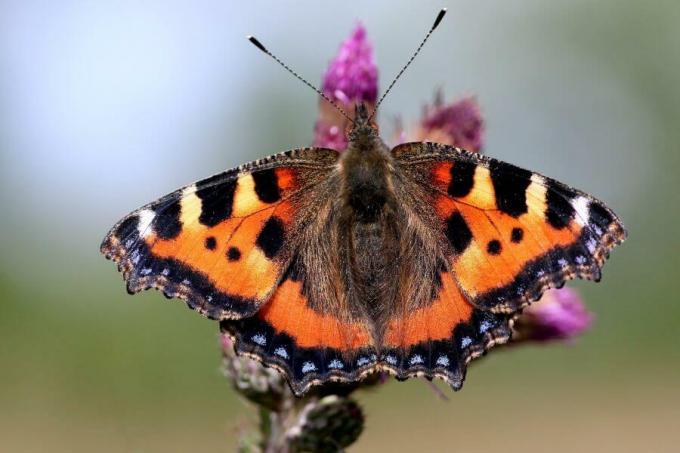
7. Admiral (Vanessa atalanta)
The admiral can often be found in the garden. This species of butterfly is not particularly specialized in its habitat requirements. It populates open landscapes with meadows and fields, can be found in forest clearings and in orchards, but also in gardens. She likes to drink from there phlox, Butterfly lilac or goldenrod. Its caterpillars feed on nettles. The admiral is dark brown on the top, surrounded by a red border. The wing tips are black with white markings. The admiral doesn't survive cold temperatures - that's why he wanders Butterfly in winter in southern regions of Europe.

8. C-folder (Polygonia c-album)
The C-Falter owes its unusual name to its unique distinguishing feature: while the top of the butterfly is patterned orange-brown, there is a striking, white "C" on the underside of the hind wings away. The C-folder is found quite frequently in Germany. He feels particularly at home in damp locations, but he also likes to visit parks and gardens. The C-butterfly especially delights ambitious gardeners: Since it prefers to drink the nectar from berry bushes, the C-butterfly is considered to be an extremely good pollinator for them. The myth that C-butterflies suck up berries, however, is wrong. Although the moths like to suckle plant juices in summer, they only use windfalls or already injured fruits. The caterpillars of the C butterfly often use the nettle and the common willow (Salix). Also the Gooseberry (Ribes uva-crispa) and the red one currant (Ribes rubrum) belong to their forage plants.
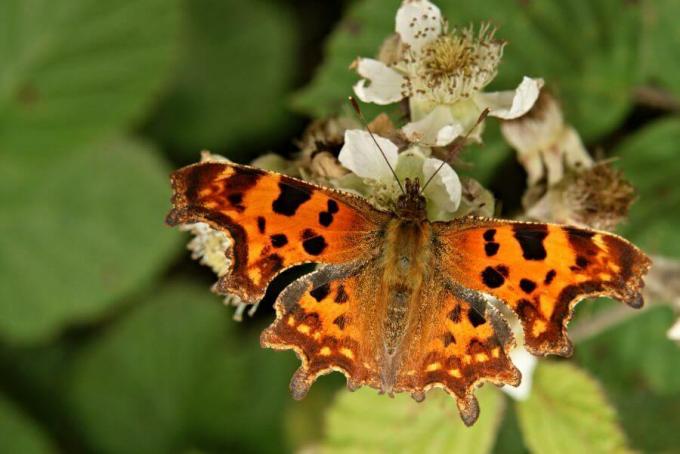
9. Chessboard (Melanargia galathea)
The chessboard was named Butterfly of the Year 2019. The butterfly catches the eye with its striking black and white pattern and prefers nutrient-poor flowering meadows, where it flies on purple to violet flowers such as thistles and scabies. However, the meadows may only be mowed at the end of July in order to be able to serve the butterfly as a source of food. The female checkerboard lets her eggs fall to the ground in flight, where the caterpillars then hatch. So leave a few corners in the garden uncut - the chessboard and other insects will gratefully accept this offer.

10. Aurora butterfly (Anthocharis cardamines)
When the meadowfoam and garlic mustache are in bloom, the aurora butterfly is not far either. The whitish butterfly lives in meadows and in sparse forests. Males differ from females by their bright orange wing tips. However, both sexes have white and green patterned wing undersides. The animals are solitary and survive the winter as pupae, from which they hatch in the spring.

11. Big fox (Nymphalis polychloros)
With an astonishing wingspan of 50 to 55 millimeters, the Great Fox is one of the giants among butterflies in Germany. With its orange-red color and its black-yellow pattern, the big fox is also a real feast for the eyes. He is often confused with the Little Fox, although the two are not closely related. Unfortunately, the big fox has become rare in Germany. Especially the loss of its habitat, that of semi-open landscapes, sunny forest edges and near-natural ones There is meadow orchards, ensure that the big fox is now on the warning list for endangered animals stands. When it comes to procuring food, however, the big fox is a real all-rounder: while the caterpillars have leaves When they eat various types of deciduous trees, the great fox feeds not only on nectar but also on sap or Windfalls. The moth does not even stop at excreta or carrion when it comes to eating.
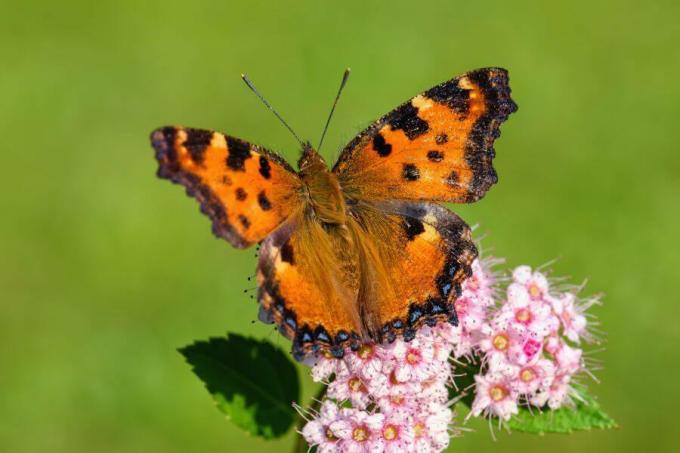
12. Imperial coat (Argynnis paphia)
The Kaisermantel inhabits natural forests, forest edges and, more recently, gardens and bushes. The males are colored intensely orange on the upper side with a black-brown pattern on the wings. Females are a bit browner, in eastern Germany there is even a bluish green color variant of the female imperial coat. The underside of the wings of the imperial coats are greenish-white with a touch of silver. The animals feed on the nectar of thistles, dost and Blackberries, but also Buddleia. They lay their eggs on tree trunks, where the caterpillars hatch and hibernate before they feed on wild violets in spring.

13. Mourning gown (Nymphalis antiopa)
The mourning cloak is a very special butterfly. Its name doesn't sound too cheerful, but it is probably due to its velvety brown surface of the wing. This is framed by a border of blue dots and finally a cream-colored, jagged border. The mourning cloak is one of the large butterfly species and can have a wingspan of up to seven and a half centimeters. However, it only feeds on willow blossoms in spring. The rest of the year he prefers windfalls and tree sap. Its natural home are open, moist forests with Pastures, Birch and elm trees. Nevertheless, it can now and then also be seen in orchards and even gardens.
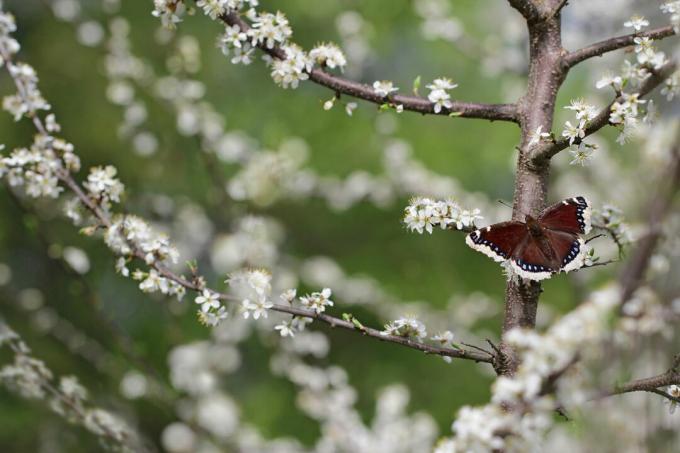
14. Blue grouse (Polyommatus icarus)
There are many different types of bluish, and as the name suggests, they have a bluish tint. The most common species is the blue-toothed Rest. The males are colored intensely blue on the upper side of the wing. Females, on the other hand, are mostly brown, but still have a bluish cast. The underside of the wings is conspicuously dotted with black and orange on a light background and the wings themselves are lined with a light fringed border. Appropriately, the butterfly only lays its eggs on peoples - such as white and horn clover.
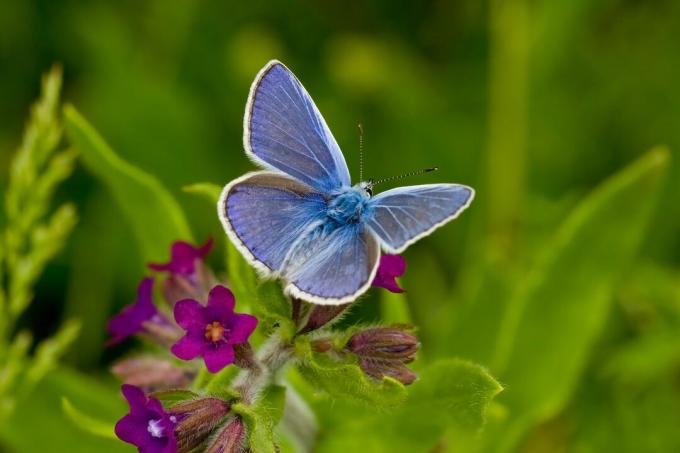
15. Little meadow bird (Coenonympha pamphilus)
Admittedly: With its brown-ocher-colored wings, the little forest bird is not exactly the most conspicuous representative of the butterflies. Nevertheless, one should not underestimate the small butterfly. Since the nectar of wild plants such as the field scabious (Knautia arvensis) or buttercup species (Ranunculus), but also daisies (Leucanthemum) and heather (Erica) are on the menu, it is considered an important pollinator. The little meadow bird is basically not picky and sucks on almost all flowering plants that it can find in its territory. The useful moth is particularly common - as its name suggests - on open grassy areas such as meadows, grasslands and pastures. Its caterpillars feed mainly on sweet grasses, for example stand Bluegrass (Poa pratensis), but also real sheep fescue (Festuca ovina) and bristle grass (Nardus) on their menu.
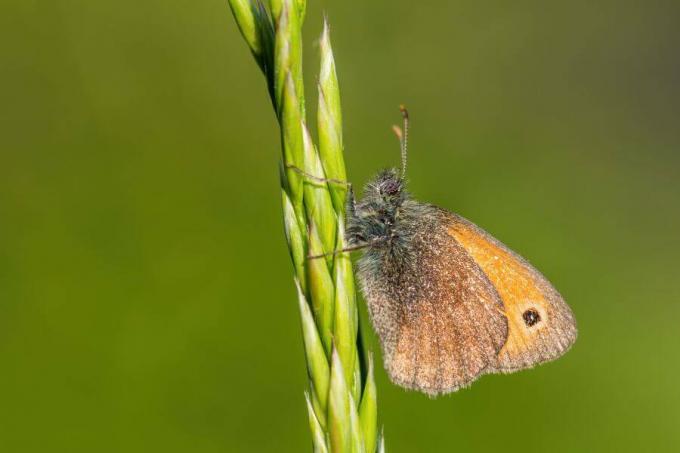
In case you have more on the topic Species diversity and biodiversity want to know, we have an article ready for you here. How to get your own Butterfly house builds, we show in this post.
